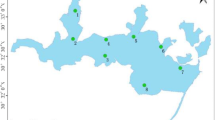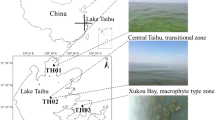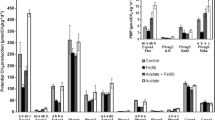Abstract
Anaerobic ammonium oxidation coupled to ferric iron reduction (Feammox) has been assumed to play an important role in nitrogen removal from ecosystems. This study assessed the potential role of Feammox in nitrogen transformation in eutrophic lake sediment using an isotope tracing technique in sediment slurry incubation experiments. Feammox was discovered in eutrophic lake sediment. A significant correlation was found between Feammox rates and iron-reducing rates. Furthermore, the positive correlations between the abundance of iron-reducing bacteria (FeRB), such as Geobacteraceae spp. and Shewanella spp., and Feammox rates indicate that Feammox was mediated by FeRB. The potential rate of Feammox in the isotopic tracer incubation treatment was 0.23–0.43 mg N kg−1 day−1. The estimated nitrogen loss caused by Feammox accounts for 5.0–9.2% of the human-induced N input annually into the eutrophic lake. Feammox alone or coupled with anaerobic ammonium oxidation (anammox) and/or denitrification may have an essential role in the nitrogen cycle within eutrophic lake sediment.





Similar content being viewed by others
References
Burger DF, Hamilton DP, Pilditch CA, Gibbs MM (2007) Benthic nutrient fluxes in a eutrophic, polymictic lake. Hydrobiologia 584:13–25
Capriulo GM, Smith G, Troy R, Wikfors GH, Pellet J, Yarish C (2002) The planktonic food web structure of a temperate zone estuary, and its alteration due to eutrophication. Hydrobiologia 475(1):263–333
Clément JC, Shrestha J, Ehrenfeld JG, Jaffé PR (2005) Ammonium oxidation coupled to dissimilatory reduction of iron under anaerobic conditions in wetland soils. Soil Biol Biochem 37(12):2323–2328
Conley DJ, Paerl HW, Howarth RW, Boesch DF, Seitzinger SP, Havens KE, Lancelot C, Likens GE (2009) Controlling eutrophication: nitrogen and phosphorus. Science 323(5917):1014–1015
Diaz RJ, Rosenberg R (2008) Spreading dead zones and consequences for marine ecosystems. Science 321(5891):926–929
Ding L-J, An X-L, Li S, Zhang G-L, Zhu Y-G (2014) Nitrogen Loss through Anaerobic Ammonium Oxidation Coupled to Iron Reduction from Paddy Soils in a Chronosequence. Environ Sci Technol 48(18):10641–10647
Ding B, Li Z, Qin Y (2017) Nitrogen loss from anaerobic ammonium oxidation coupled to Iron(III) reduction in a riparian zone. Environ Pollut 231:379–386
Ding W, Wu T, Qin B, Lin Y, Wang H (2018) Features and impacts of currents and waves on sediment resuspension in a large shallow lake in China. Environ Sci Pollut Res 25(36):36341–36354
Emerson D, Moyer C (1997) Isolation and characterization of novel iron-oxidizing bacteria that grow at circumneutral pH. Appl Environ Microbiol 63(12):4784–4792
Gao W, Swaney DP, Hong B, Howarth RW, Liu Y, Guo H (2015) Evaluating anthropogenic N inputs to diverse lake basins: a case study of three Chinese lakes. Ambio 44(7):635–646
Guangwei Z, Boqiang Q, Yunlin Z, Hai X, Mengyuan Z, Hongwei Y, Kuanyi L, Shen M, Ruijie S, Chunni Z (2018) Variation and driving factors of nutrients and chlorophyll-a concentrations in northern region of Lake Taihu, China, 2005 -2017. J Lake Sci 30(02):279–295 (in Chinese)
Harms G, Layton AC, Dionisi HM, Gregory IR, Garrett VM, Hawkins SA, Robinson KG, Sayler GS (2003) Real-time PCR quantification of nitrifying bacteria in a municipal wastewater treatment plant. Environ Sci Technol 37(2):343–351
Hongtao D, Ronghua M, Xiaofeng X, Fanxiang K, Shouxuan Z, Weijuan K, Jingyan H, Linlin S (2009) Two-decade reconstruction of algal blooms in China’s Lake Taihu. Environ Sci Technol 43(10):3522–3528
Huang S, Jaffé PR (2015) Characterization of incubation experiments and development of an enrichment culture capable of ammonium oxidation under iron-reducing conditions. Biogeosciences 12(3):769–779
Huang S, Jaffé PR (2018) Isolation and characterization of an ammonium-oxidizing iron reducer: Acidimicrobiaceae sp A6. PLoS One 13(4)
Huang S, Chen C, Peng X, Jaffé PR (2016) Environmental factors affecting the presence of Acidimicrobiaceae and ammonium removal under iron-reducing conditions in soil environments. Soil Biol Biochem 98:148–158
Huang C, Zhang L, Li Y, Lin C, Huang T, Zhang M, Zhu Ax, Yang H, Wang X (2018) Carbon and nitrogen burial in a plateau lake during eutrophication and phytoplankton blooms. Sci Total Environ 616:296–304
Janssen ABG, de Jager VCL, Janse JH, Kong X, Liu S, Ye Q, Mooij WM (2017) Spatial identification of critical nutrient loads of large shallow lakes: Implications for Lake Taihu (China). Water Res 119:276–287
Jensen MM, Thamdrup B, Dalsgaard T (2007) Effects of specific inhibitors on anammox and denitrification in marine sediments. Appl Environ Microbiol 73(10):3151–3158
Jia R, Li L, Qu D, Mi N (2018) Enhanced iron(III) reduction following amendment of paddy soils with biochar and glucose modified biochar. Environ Sci Pollut Res 25(1):91–103
Li XF, Hou LJ, Liu M, Zheng YL, Yin GY, Lin XB, Cheng L, Li Y, Hu XT (2015) Evidence of nitrogen loss from anaerobic ammonium oxidation coupled with ferric iron reduction in an intertidal wetland. Environ Sci Technol 49(19):11560–11568
Lovley DR, Phillips EJP (1987) Rapid assay for microbially reducible ferric iron in aquatic sediments. Appl Environ Microbiol 53(7):1536–1540
Lovley DR, Phillips EJP (1988) Novel mode of microbial energy-metabolism - organic-carbon oxidation coupled to dissimilatory reduction of iron or manganese. Appl Environ Microbiol 54(6):1472–1480
Lu Q, He ZL, Graetz DA, Stoffella PJ, Yang X (2010) Phytoremediation to remove nutrients and improve eutrophic stormwaters using water lettuce (Pistia stratiotes L.). Environ Sci Pollut Res 17(1):84–96
Ma J, Qin B, Paerl HW, Brookes JD, Hall NS, Shi K, Zhou Y, Guo J, Li Z, Xu H, Wu T, Long S (2016) The persistence of cyanobacterial (Microcystis spp.) blooms throughout winter in Lake Taihu, China. Limnol Oceanogr 61(2):711–722
Meier J, Costa R, Smalla K, Boehrer B, Wendt-Potthoff K (2005) Temperature dependence of Fe(III) and sulfate reduction rates and its effect on growth and composition of bacterial enrichments from an acidic pit lake neutralization experiment. Geobiology 3(4):261–274
Melton ED, Stief P, Behrens S, Kappler A, Schmidt C (2014a) High spatial resolution of distribution and interconnections between Fe- and N-redox processes in profundal lake sediments. Environ Microbiol 16(10):3287–3303
Melton ED, Swanner ED, Behrens S, Schmidt C, Kappler A (2014b) The interplay of microbially mediated and abiotic reactions in the biogeochemical Fe cycle. Nature reviews. Microbiology 12(12):797–808
Myers CR, Nealson KH (1988) Microbial reduction of manganese oxides - interactions with iron and sulfur. Geochim Cosmochim Acta 52(11):2727–2732
Oshiki M, Ishii S, Yoshida K, Fujii N, Ishiguro M, Satoh H, Okabe S (2013) Nitrate-dependent ferrous iron oxidation by anaerobic ammonium oxidation (Anammox) bacteria. Appl Environ Microbiol 79(13):4087–4093
Park W, Nam Y-K, Lee M-J, Kim T-H (2009) Anaerobic ammonia-oxidation coupled with Fe3+ reduction by an anaerobic culture from a piggery wastewater acclimated to NH4+/Fe3+ medium. Biotechnol Bioprocess Eng 14(5):680–685
Sawayama S (2006) Possibility of anoxic ferric ammonium oxidation. J Biosci Bioeng 101(1):70–72
Shrestha J, Rich JJ, Ehrenfeld JG, Jaffé PR (2009) Oxidation of ammonium to nitrite under iron-reducing conditions in wetland soils laboratory, field demonstrations, and push-pull rate determination. Soil Sci 174(3):156–164
Smith VH (2003) Eutrophication of freshwater and coastal marine ecosystems - a global problem. Environ Sci Pollut Res 10(2):126–139
Somenahally AC, Hollister EB, Yan W, Gentry TJ, Loeppert RH (2011) Water management impacts on arsenic speciation and iron-reducing bacteria in contrasting rice-rhizosphere compartments. Environ Sci Technol 45(19):8328–8335
Sorensen J (1978) Denitrification rates in a marine sediment as measured by acetylene inhibition technique. Appl Environ Microbiol 36(1):139–143
Straub KL, Benz M, Schink B (2001) Iron metabolism in anoxic environments at near neutral pH. FEMS Microbiol Ecol 34(3):181–186
Trimmer M, Nicholls JC (2009) Production of nitrogen gas via anammox and denitrification in intact sediment cores along a continental shelf to slope transect in the North Atlantic. Limnol Oceanogr 54(2):577–589
Wu T, Qin B, Brookes JD, Yan W, Ji X, Feng J (2019) Spatial distribution of sediment nitrogen and phosphorus in Lake Taihu from a hydrodynamics-induced transport perspective. Sci Total Environ 650:1554–1565
Yang WH, Weber KA, Silver WL (2012) Nitrogen loss from soil through anaerobic ammonium oxidation coupled to iron reduction. Nat Geosci 5(8):538–541
Yang Z, Zhang M, Shi X, Kong F, Ma R, Yu Y (2016) Nutrient reduction magnifies the impact of extreme weather on cyanobacterial bloom formation in large shallow Lake Taihu (China). Water Res 103:302–310
Yang Y, Zhang Y, Li Y, Zhao H, Peng H (2018) Nitrogen removal during anaerobic digestion of wasted activated sludge under supplementing Fe(III) compounds. Chem Eng J 332:711–716
Yao H, Conrad R (2000) Effect of temperature on reduction of iron and production of carbon dioxide and methane in anoxic wetland rice soils. Biol Fertil Soils 32(2):135–141
Zhang M, Shi X, Yang Z, Yu Y, Shi L, Qin B (2018) Long-term dynamics and drivers of phytoplankton biomass in eutrophic Lake Taihu. Sci Total Environ 645:876–886
Zhou S, Borjigin S, Riya S, Terada A, Hosomi M (2014) The relationship between anammox and denitrification in the sediment of an inland river. Sci Total Environ 490:1029–1036
Funding
This work was financially supported by the National Natural Science Foundation of China (51609234) and the Natural Science Foundation of Jiangsu Province (BK20161089).
Author information
Authors and Affiliations
Corresponding author
Additional information
Responsible editor: Robert Duran
Publisher’s note
Springer Nature remains neutral with regard to jurisdictional claims in published maps and institutional affiliations.
Highlights
1. Tracer studies with 15NH4+ manifested the occurrence of Feammox in eutrophic lake sediment.
2. The potential rate of Feammox in the isotopic tracer incubation test was 0.23–0.43 mg N kg−1 day−1.
3. FeRB played a critical role in the microbially catalyzed Feammox process.
4. N2 was the major product of Feammox process in eutrophic lake sediment.
Electronic supplementary material
ESM 1
(DOCX 70 kb)
Rights and permissions
About this article
Cite this article
Yao, Z., Wang, F., Wang, C. et al. Anaerobic ammonium oxidation coupled to ferric iron reduction in the sediment of a eutrophic lake. Environ Sci Pollut Res 26, 15084–15094 (2019). https://doi.org/10.1007/s11356-019-04907-7
Received:
Accepted:
Published:
Issue Date:
DOI: https://doi.org/10.1007/s11356-019-04907-7




